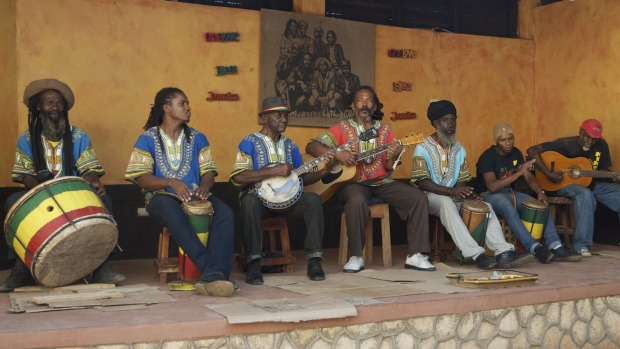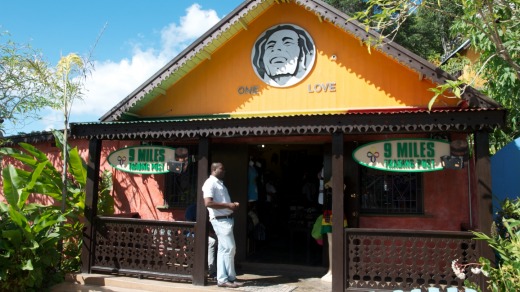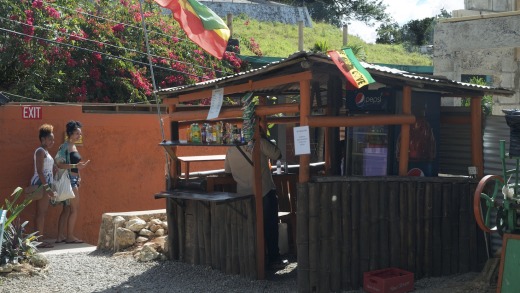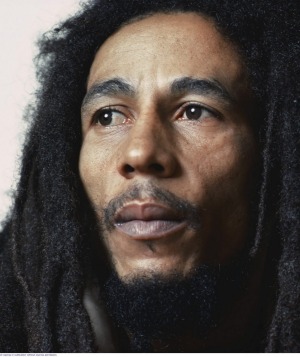
If Bob Marley were still alive, he'd be 70 this year.
Although the Jamaican singer-songwriter, activist and Haile Selassie's gift to women died at 36, his music continues to be played globally with almost religious dedication. At his birthplace – a small town in Jamaica's Saint Ann parish – is the Bob Marley Mausoleum on Mount Zion. My journey there reveals various spirits in play.
"Here we say the first drink of Jamaican rum opens your eyes, the second you see Jesus and the third you meet Jesus." Tameika pours Caribbean-sized nips of bright orange rum punch from a repurposed four-litre juice bottle and passes plastic cups around the minibus as Delroy drives us from Falmouth. Tameika has already taught us to say "yes" and "happy" in Jamaican Patios – yeah man, irie – but our words don't ring from our mouths in quite the same way hers do.

Falmouth became a port in the 1800s for sugarcane and molasses. Now it accommodates all cruise ships great and small such as my own massive mode of transport: Royal Caribbean's Oasis of the Seas. My first time in the Jamaican sunshine, I chose this Bob Marley Experience shore excursion to see as much of the countryside as possible in an eight-hour stopover and because, well, it's Bob.
Robert Nesta Marley was born in 1945 on a farm in Nine Mile. At 12 he moved to Trenchtown, Kingston. By 18, Marley was one of The Wailers and Jamaica had gained its independence from Britain. In 1966 Marley moved, newly married, to the US and worked as a lab assistant then on a Chrysler plant assembly line. But he soon returned home, converted from Catholicism to the Rastafari faith and worked on his dreadlocks. After The Wailers disbanded in 1974, Marley pursued a solo career and released Exodus, which has sold more than 75 million copies. Marley loved football and the lists of the children he fathered are inexhaustive.
Being here in Jamaica breathes life into these facts.

As Delroy steers off the highway, Tameika slips a CD into the minibus disc player and for a couple of hours we pass yam fields and ackee trees, goats on soccer fields, busy towns, sleepy villages and mountain vistas Marley called "mystic views" while calypso, ska, rocky steady and reggae skip on the bumps.
I feel irie.
Some Nine Mile locals meet the bus at the gates of the Marley property. One wears a large, multicoloured knitted beanie. Passengers who seemed apathetic on board leap off the bus to stand in line. I assume they're massive Bob Marley fans and join the queue. Until I realise it's not the line to get in.

The way to Zion is upstairs and across the courtyard, through the gift shop where someone asks me if I'm a model, through the bar for more rum or free "liquid sunshine" water, past the reggae musicians where someone proposes marriage and through the double gates. Tropical plants, of Jamaica flag green, shade the sides of two chapels and a small stone house said to be where Marley was born. Between them, in the concrete, is the reggae "rockstone' on which Marley sought inspiration for songs.
"Fuzzy says welcome to the foundation of Bob Marley." Our guide is Marley's cousin, who is 72 and mainly talks in the third person. "Anything about Bob Marley, you ask Fuzzy."
We take off our shoes to enter Mama's mausoleum, then her son's. "No clicky, clicky, my angels," but we're encouraged to touch the marble that entombs Marley's body. He lies "above the earth" with his brother, a bible, herb, guitar, soccer ball – "everything to keep him irie".
Marley died in May 1981 after cells from a malignant melanoma under the nail of a toe, which he didn't have amputated for religious reasons, spread to his lungs and brain. He died in Miami trying to get home from a cancelled European tour.
"Now you know the real Jamaica," Fuzzy says. In fact, there hasn't been a single moment of this excursion when I didn't feel I was getting to know the true Jamaica. Maybe Jamaica never thinks to be anything but its authentic self, and perhaps that's at the heart of Bob Marley and reggae music's enduring appeal.
On the loop back to Falmouth, Delroy pulls off at Bumper Lawn for jerk chicken, jerk pork, festival dumplings, and rice and peas that Tameika calls "country style, no fancy food".
I return to the ship on a natural high.
www.royalcaribbean.com.au
Qantas flies daily from Sydney to Fort Lauderdale (via Dallas) and Melbourne to Fort Lauderdale (via Los Angeles). Phone 131313, see www.qantas.com.au.
Oasis of the Seas sails seven-night Western Caribbean cruises every fortnight departing Fort Lauderdale (Florida, US) year round.
Established in the mid-1700s, this sugar plantation eventually expanded into a village to house former workers after emancipation. A tour of Good Hope is a great way to learn about Jamaica's colonial history, walking through the renovated Great House and visiting the onsite pottery workshop before a barbecue lunch.
After a wander through Miss Martha's Herb Garden, take a load off while a local guide steers you down the river for five kilometres through the lush Jamaican landscape on a 10-metre bamboo raft. Chuck Norris and Queen Elizabeth II have apparently also done this.
These natural seaside cascades in Ocho Rios are the site of an historic battle between the Spanish and the British in 1657, as well as a super popular local swimming spot.Walk with your guide to the top of the 180-metre falls for the best ocean view or just loll in one of the lagoons.
Learn how to cook your own spicy jerk chicken and doughy Jamaican festivals on the verandah of Great House. This tour also includes a stroll through the garden of the estate and, of course, a good taste of your own medicine.
The limestone karst formations and underground lakes of these caves have hidden runaway slaves and weapons being smuggled to Cuba. They were also a hideout for the Spanish during the takeover of the island by the English in 1655. Learn more as you're guided through the eerie passageways and chambers. See www.royalcaribbean.com.au